1993-2014 Trainees
Trainees listed here entered the program in the years indicated.
- 2014 Trainees
- 2013 Trainees
- 2012 Trainees
- 2011 Trainees
- 2010 Trainees
- 2009 Trainees
- 2008 Trainees
- 2007 Trainees
- 2006 Trainees
- 2005 Trainees
- 2004 Trainees
- 2003 Trainees
- 2002 Trainees
- 2001 Trainees
- 2000 Trainees
- 1999 Trainees
- 1993 - 1997 Trainees
2014 Trainees

Sean Allen
2009 BA from UC Berkeley in Molecular and Cell Biology
2013 MS from San Francisco State University in Cell and Molecular Biology
PhD Adviser: Evan Scott
Doctoral Research Project:
I plan on using the Scott Lab's diblock copolymer nanocarriers to better understand the role of T-cells in atherosclerotic plaque formation and growth. I hypothesize that the ROCK pathway in T-cells plays a proinflammatory role in the atherosclerotic plaque, and inhibiting this pathway will result in decreased plaque growth and formation. I will target polymer vesicles carrying ROCK inhibitor to T-cells in the atherosclerotic plaque by functionalizing their surface with MHC-oxLDL conjugates, which will specifically target the TCR of T-cells already in the plaque, and will avoid off target delivery to other T-cells in the body

Edward Goncz
2013 BS Biochemistry and Molecular Biology,Pennsylvania State University
PhD Adviser: Eric Weiss
Doctoral Research Project:
Recent work has identified a large and poorly understood group of evolutionary conserved short, linear motifs in S. cerevisiae.These peptide motifs occur in unstructured protein regions that, though lacking enzymatic function or structurally characterized protein domains, are critical for proper protein communication. I work at the interface of chemistry and biology to develop and design new methods for studying these protein-peptide interactions. I currently work with a novel, UV activated cross-linker to detect and map low affinity interactions between proteins and short, linear peptide motifs.Using this method, I plan to identify novel protein-peptide interactions that will both enhance our understanding of how proteins use unstructured regions to communicate as well as how these regions can expand the potential networks within which proteins communicate.
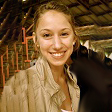
Jessica Stark
2012 BS Chemical Engineering, Cornell University
PhD Adviser: Mike Jewett
Doctoral Research Project:
Inexpensive and efficient technologies to produce recombinant proteins have enabled the use of proteins as therapeutics to treat complex diseases such as cancer. Cell-free protein synthesis is a novel protein production strategy that uses cell lysates, or the molecules inside a cell, to carry out protein synthesis in vitro. The cell-free protein synthesis approach allows for more rapid and efficient conversion of substrates to protein products by removing the need to maintain cell viability and enables precise control of reaction conditions not possible in living cells. My research is focused on enabling glycosylation, an important post-translational modification, in this system and characterizing the effects of this modification on protein structure and function. This work promises to enable the rapid production of proteins with customizable glycosylation for use as novel medicines or materials.
2013 Trainees

Benjamin Des Soye
2011 BS Bioinformatics Computational Biology, B.A. Mathematics, SUNY Buffalo
PhD Adviser: Michael Jewett
Doctoral Research Project:
As an undergraduate, Ben was involved in a number of projects including elucidating the role of connexin proteins in human melanoma invasive and migratory potential, exploring gross changes in nuclear architecture linked to disease states, and characterizing histone modification dynamics associated with various genomic regions in Drosophila melanogaster>. In Dr. Jewetts lab, Bes research is largely focused around optimizing E. coli-based cell-free protein synthesis systems for cotranslational incorporation of non-natural amino acids via amber-suppression. He hopes to improve upon existing methods to develop systems capable of increased yields of site-specifically modified, complex protein products useful for downstream applications including further research investigation and therapeutics.

Justin Finkle
2011 BS Biological Engineering, Cornell University
PhD Adviser: Neda Bagheri
Doctoral Research Project:
A more complete understanding of cellular control mechanisms, using systems biology, has great potential to advance the field of biotechnology. Furthermore, an accurate description of network kinetics will help provide crucial mechanistic insight for improving and validating a systems model. I aim to integrate these approaches to elucidate the biological regulatory networks governing disease mechanisms. Such insight will inform treatment strategies, direct the discovery of drug targets, and guide researchers in their choices as they design cells for diverse applications.

Jeffrey Mao-Hwa Liu
2012 BA Molecular and Cell Biology, Biochemistry and Molecular Biology, University of California, Berkeley
PhD Adviser: Lonnie Shea
Doctoral Research Project:
Jeff is working under Dr. Lonnie Shea on the characterization of regulatory T cells and their potential role in developing immunomodulatory strategies for islet transplantation and tolerance induction. Regulatory T cells or Tregs are crucial for maintaining immune homeostasis by regulating and suppressing immune response. Due to their localized and potentially antigen-specific suppressive effects, Tregs are a promising alternative to standard tissue transplantation tolerance induction strategies which often involve systemic immune suppression. Early work has shown islets transplanted within a porous PLG scaffold to treat type 1 diabetes mellitus can be protected by both a) cotransplantation of in-vitro induced Tregs and b) secretion of Treg-inducing factors like TGF-. The goal of this work to identify factors or strategies to enhance the local recruitment and/or differentiation of Tregs for the protection of transplanted islets against host immune response. Aspects of this project include identification of the dynamic gene regulatory network governing in vitro-Treg differentiation and the characterization of Tregs recruited to the islet-protective scaffold using different secreted cytokines and factors.

Kelly Anne Schwarz
2012 BS Chemical and Biomolecular Engineering, Johns Hopkins University
PhD Adviser: Josh Leonard
Doctoral Research Project:
Kelly's project involves engineering synthetic cell surface receptor proteins that respond to extracellular cues such as proteins or pathogens. Her lab has already developed a technology termed a Modular Extracellular Sensor Architecture (MESA), a completely orthogonal, ligand-inducible protein receptor system. However, while MESA along with other technologies in the synthetic biology field have demonstrated the ability to regulate cellular activity, no approach allows for the simultaneous induction multiple distinct genetic programs.Therefore, the overall goal of her project is to fill this void by modifying MESA to create a family of synthetic mammalian cell surface receptors that respond to multiplexed extracellular signals (such as biodegradable particles patterned with ligands) by regulating the induction of engineered gene circuits. Such a technology could be used for the remote tuning of cell-based therapies post-implantation or for controlling the cell state within a tissue engineering scaffold.
2012 Trainees

Devang Amin
2008 BSE Chemical Engineering, Princeton University
PhD Adviser: Phil Messersmith
Doctoral Research Project:
As an undergraduate, he had done research on the synthesis and characterization of functionalized polybutadienes. At Northwestern, he has done rotations working with gold nanoparticles for microRNA delivery and carbon nanotubes for delivery of macromolecules. In Phillip Messersmith's laboratory, he is working with using polydopamine nanoparticles for cancer drug delivery. The utility of polydopamine stems from its facile synthesis and the chemical versatility of the catechol groups found on dopamine. Polydopamine nanoparticles are spontaneously formed upon the addition of dopamine into a basic aqueous solution exposed to air. This bio-inspired reaction proceeds by a mechanism quite similar to that of melanin formation in the human body. Each dopamine molecule contains a catechol moiety, which can react with a plethora of other molecules by interactions including covalent bonding to amines and thiols, pi-pi stacking with aromatic compounds, hydrogen bonding, coordination of metal ions, and electrostatic interactions. By utilizing the chemical versatility of polydopamine nanoparticles, he is working toward creating a bio-inspired, readily synthesized multifunctional platform for drug delivery. This platform will ultimately contain imaging agents, chemotherapeutic drugs, and targeting molecules to improve selectivity of uptake into cancer cells.

Nikhita Mansukhani
2011 BS Physics, Minor/Chemistry, University of Illinois-Urbana/Champaign
PhD Adviser: Hersam
Doctoral Research Project:
Niki is currently working on the biomedical applications of functionalized carbon nanomaterials under the direction of Professor Mark Hersam, with a focus on gene delivery and real-time imaging. Although gene delivery has been on the forefront of medical research for decades, an optimal method has not been realized. Carbon nanotubes and graphene have remarkable properties that make them well-suited for gene therapy: they are biocompatible when well dispersed, exhibit strong interactions with nucleic acids, and absorb at specific frequencies the near-infrared region depending on their surface functionalization and physical properties. In addition, they exist in a variety of diameters and lengths, lending them the potential for multi- gene delivery. The goal of this project is to achieve spatially and time-resolved multi-gene delivery and near- infrared imaging using carbon nanotubes.

Dante Alberto Pertusi
2011 BS Chemical Engineering, Michigan State University
PhD Adviser: Keith Tyo
Doctoral Research Project:
His research involves using computational methods to develop novel metabolic pathways for the synthesis of value-added chemicals. The in silico software, BNICE, is capable of performing all the enzymatic reactions possible on a given substrate, across several generations. This system is unique in that it offers the possibility of pathways that progress through compounds that are biologically novel. Given that the networks generated by BNICE grow exponentially, one aspect of his project has been to focus the network generation towards a particular target. By utilizing the network-pruning algorithms, it is possible to develop lengthier pathways that offer the potential to link feedstock molecules with intended targets. Other aspects of his work include thermodynamic analysis of BNICE-generated pathways, chemical similarity analyses of both native and novel pathways, and mining existing databases for enzymes that have the greatest potential to drive novel BNICE pathways forward.
2011 Trainees
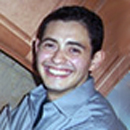
Brian Alberto Aguado
BS 2010 - Biomechanical Engineering, Stanford University
PhD Thesis Adviser: Ramille Shah
Doctoral Research Project:
Induced pluripotent stem (iPS) cells have the capacity to differentiate into any adult cell type, and hold significant promise in research involving drug development, disease modeling, and regenerative medicine. Compared to human embryonic stem (hES) cells, iPS cells are a more practical and ethical stem cell source since they can be derived entirely from genetically reprogrammed somatic cells. Despite encouraging results for using iPS cells for various applications, extremely inefficient cell reprogramming in 2D monolayer culture limits their widespread experimental use. To address these limitations, my research proposes a 3D cell culture system to increase iPS cell derivation efficiency through viral and non-viral gene delivery mechanisms. I aim to determine if and how a 3D microenvironment can affect the genetic reprogramming of adult somatic cells into iPS cells. This research may uncover novel and more effective strategies for iPS derivation, which may bring us closer to their use for drug screening and regenerative therapies.
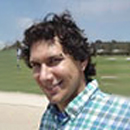
Mark Thompson Duncan
2008 BS Chemical Engineering, UCLA
PhD Adviser: William Miller
Doctoral Research Project:
His research project involves elucidating the role of the sirtuin deacetylases (SirTs) in megakaryocyte (platelet-precursor cell) differentiation. SirT inhibition has previously been demonstrated to greatly enhance megakaryocyte maturation ex vivo, and thus represents an important step towards generating culture-derived platelets at a clinically relevant scale. In addition, Mark is developing a novel bioreactor to facilitate semi-continuous production/harvest of platelets from culture-derived megakaryocytes.

Kelan Hlavaty
2010 BS Biomedical Engineering, Central Michigan University
PhD Thesis Adviser: Lonnie Shea
Doctoral Research Project:
I am currently working under the direction of Lonnie Shea and am investigating islet transplantation and allogeneic immune responses. In cell and organ transplantations, donor tissue is commonly derived from an allogeneic source, initiating an adverse immune response and rejection by the host immune system. Consequently, life-long immunosuppressive therapies are necessary to delay graft rejection. Unfortunately, these therapies result in toxic effects on transplanted cells and an increased risk for infections. My work aims to generate a method to induce donor-specific tolerance using PLG nanoparticles containing donor antigens. I will show this through transplanting islets to treat type 1 diabetes mellitus, an autoimmune disorder in which the body destroys the insulin-producing islet cells of the pancreas. My goal is to create a biodegradable, cell-free product for indefinite protection of allogeneic islet grafts and understand the fundamental mechanisms of tolerance induction.
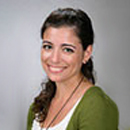
Keila Margarita Torre-Santiago
2008 BA Biochemistry, Wellesley College
PhD Adviser: Sadie Wignall
Doctoral Research Project:
Her project involves applying imaging technologies to investigate how chromosomes congress and segregate in meiotic cell divisions. Using new and cutting-edge microscopy, she is using knock-down models of two proteins (dynein and other kinesin-like proteins) to determine their effect on chromosome organization and segregation. She will be trained by a collaborator on the DeltaVision OMX, which uses structures illumination to achieve 3D images.
2010 Trainees

Brian Fritz
BS 2008 - Chemical Biological Engineering and Biochemistry , University of Wisconsin - Madison
PhD Thesis Adviser: Michael Jewett
Doctoral Research Project:
In vivo protein production from a gene of interest requires insertion of the genetic material into the host cell, recognition by and compatibility with the host cell machinery, and redirection of substrates towards production of the particular protein. The host cell must balance the new user-defined objective with the need to survive and replicate. Cell-free protein synthesis has been developed to remove cell viability constraints, to more efficiently convert substrates to protein products, and to enable exquisite control of reaction conditions. My research explores new applications of cell-free protein synthesis and other synthetic biology tools to construct synthetic ribosomes. My work aspires to bring new chemistry to biology, whilst exploiting the most salient feature of biology - its ability to evolve - in search of new pharmaceuticals and materials.
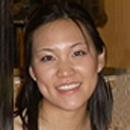
Michele Jen
BS 2007 - Biomedical Engineering, University of Texas-Austin
PhD Thesis Adviser: Guillermo Ameer
Doctoral Research Project:
Direct protein delivery from scaffolds generally poses several challenges such as limited protein loading capacity onto scaffolds, decreased effectiveness of the protein for extended periods, and altered protein function due to immobilization techniques onto scaffolds. For these reasons, much attention has been paid to gene delivery as an alternative approach by allowing the transfected seeded or infiltrating cells to express the desired protein for prolonged periods. The goal of my project is to use poly (diol-co-citrates) or PDC as a substrate-mediated gene delivery system. PCCD scaffolds offer great flexibility by modifying the degradation rate, pore size, and degree of porosity to influence gene loading capacity and cellular infiltration. Furthermore, because PCD can be modified to mimic native tissues such as bone, cartilage, and vascular tissue, it holds great promise for gene therapy in a variety of applications.
2009 Trainees
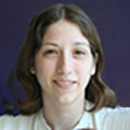
Nichole Daringer
BSE 2008 - Chemical Engineering, University of Iowa
PhD Thesis Adviser: Joshua Leonard
Doctoral Research Project:
Many approaches that attempt to harness the immune system to fight cancer are unsuccessful because they fail to overcome the immunosupressive microenvironment of the tumor. Many tumors develop the ability to secrete cytokines such as IL-10 and TGF-that send immunosuppressive signals to immune system. Immune cells exposed to this tumor microenvironment not only ignore the tumors as a threat but also help the tumors grow by assisting with angiogenesis and other mechanisms. I am working to reprogram macrophages so that they respond to the immunosuppressive microenvironment of tumors with a proinflammatory response. This will be done by creating a toolbox that combines synthetic biology with pathway engineering to transmit inflammatory signals to immune cells within the tumor microenvironment. Reversing the immunosuppressive microenvironment will allow the immune system to recognize the tumor as a threat and remove it.
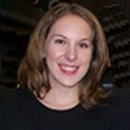
Lisa Manus
BS 2007 Biochemistry and Molecular Biology, Illinois State University
BS 2007 Chemistry, Illinois State University
PhD Thesis Adviser: Thomas J. Meade
Doctoral Research Project:
Magnetic resonance imaging (MRI) is a noninvasive diagnostic and research tool that provides detailed images of internal structures. The sensitivity (or contrast) of an MR image can be enhanced through the use of Gd(III)-complexes. My research involves the development of nanoparticle-based theranostic probes that would (1) augment chemotherapeutic treatment and (2) provide simultaneous, noninvasive diagnostic information on the physiological status of tumors that can be correlated to chemotherapeutic efficacy. In collaboration with Prof. Dean Ho (Biomedical Engineering, Northwestern University), we have developed a Gadolinium(III)-nanodiamond conjugate (Gd-ND) visible by MRI. Gd-ND has a measured relaxivity more than 1 order of magnitude higher than existing Gd(III) clinical agents. This level of enhancement is proposed to be unique to Gd-ND due the inherent water-nanodiamond interaction properties. Currently, I am investigating the environment at the water-Gd-ND interface in addition to expanding on imaging and targeting possibilities of nanodiamonds including multimodal nanodiamonds and chemotherapeutic Gd-ND theranostic systems.

Adam Pah
Chemical Engineering Department
BS 2008 Molecular Biosciences and Biotechnology, Arizona State University
PhD Thesis Advisor: Luis Amaral
Doctoral Research Project:
Metabolism is a cornerstone of life, with most of the enzymes and reactions conserved over a dizzying array of organisms. Intense study over the past century has allowed us to elucidate the metabolic pathways for a number of organisms. While this gives us the circuitry of metabolism, it does not give insight into the role that evolution has played in shaping metabolism and an understanding of why metabolism is constructed as we know it to be. These limitations prevent us from formulating a coherent, organism-independent theory of metabolism. This problem becomes increasingly more important as we push the boundaries of synthetic organism design, drug development and food science. To investigate the underlying organization of metabolism we employ a systems-level analysis to evaluate metabolic networks and metabolite roles, both cartographic and biological. This analysis will allow us to probe two distinct properties of this system: (i) the underlying organization of metabolites and its relationship to the roles that they have in the metabolic network and (ii) the effect of evolution on the exploration of functional property space in metabolism.
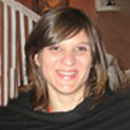
Beatriz Penalver Bernable
BS 2000 - Chemical Engineering, University of Murcia, Spain
MS 2004 - Chemical Engineering, University of Massachusetts, Amherst, Massachusetts
PhD Thesis advisers: Linda Broadbelt and Lonnie Shea
Doctoral Research Project:
Cells can grow, proliferate, migrate, differentiate or die and the final decision is based on a delicate combination of all internal and external stimuli that the cell senses. Understanding cell dynamics, from their own regulation to their interaction with other cells and the extracellular matrix, has applications in a vast number of areas from stem cell differentiation to unraveling complex diseases such as cancer. The aim of my research is to delineate networks of signaling pathways in specific cells and develop appropriate mathematical models that can later have direct application in the diagnosis and treatment of diseases. My thesis research focuses on the development of models of signaling pathways in vivo and in vitro follicle maturation using an array of tools from Systems Biology. Follicle maturation in vitro has been accomplished in different systems using three-dimensional designed environments, which are ideal to study gene expression at different stages of follicle maturation. Using the results of microarray analysis, I am trying to understand the maturation process and the factors that control and affect it. I am also developing models that explain growth of the follicle over time based on the complex signals that control it, including secreted molecules, autocrinal and paracrinal signaling, extracellular matrix signals and characteristics of the mechanical environment. The final goal of my research is translating these models into other species so that successful in vitro follicle maturation can be achieved in humans and extended to endangered species.
2008 Trainees

Romie Gibly

Trisha Koenke

Jason Mantei
2007 Trainees

Lindsay Karfield

Swapna Panuganti
Chemical Biological Engineering Department
B.S. 2005 - Chemical Engineering and Biology
Massachusetts Institute of Technology
PhD Thesis Advisor:William M. Miller
Doctoral Research Project:
Hematopoietic stem cells have the ability to give rise to all the different types of blood cells in the body. This research in particular focuses on the mechanisms of hematopoietic stem cell differentiation into megakaryocytes, the precursors to platelets. Platelets are essential for clotting, wound healing, and hemostasis. Other hematopoietic lineages of interest also include granulocytes, which comprise the majority of human white blood cells, and erythrocytes. Due to limited availability of normal human blood donors, there's an increasing stress on current blood bank supplies to harvest blood cells necessary for transfusion. To obtain just one unit of platelets for transfusion, 6-8 units of donated blood must be pooled from several different donors, which can lead to an increased risk of an immune response from the recipient. An attractive alternative is to augment peripheral blood stocks by transplanting megakaryocyte progenitors or fully differentiated platelets derived from ex vivo expanded hematopoietic stem cells. This research involves evaluating various growth factors and additives as well as manipulating the growth environment of hematopoietic stem cells in culture to enhance their expansion and maturation into megakaryocytes. Nicotinamide, a novel additive to hematopoietic stem cell culture that is safely tolerated at high doses in human patients, has been shown to greatly enhance the platelet-producing potential of megakaryocytes in culture. Elucidating the mechanisms through which nicotinamide functions in primary human hematopoietic stem cells has the possibility of leading to its evaluation in a mouse model and perhaps a clinical trial so patients waiting for a platelet transfusion have the possibility of producing their own platelets autologously.
2006 Trainees

Samuel Seaver
Department of Chemistry
B.Sc. 2000 - Molecular Biology and Biochemistry, Durham University, UK
M.Sc. 2001 - Molecular Modelling and Bioinformatics, Birkbeck College, University of London, UK
PhD Thesis advisor:Luis N. Amaral
Doctoral Research Project:
The growing volume of experimental data that confirm the location and sequence of transcription factor binding sites (TFBS) now means that computational models of TFBS can be tested with greater accuracy and reliability. In particular, the size of the TFBS dataset at RegulonDB allows us to study the TFBS distribution and degeneracy in upstream regions of Escherichia coli. The focus of my work is to find trends in the dataset that can be explained using simple mathematical and computational models inspired by biological processes. The result of this work will boost our understanding of bacterial gene regulation in general, gene regulation involving specific transcription factors, and the evolutionary processes involved.
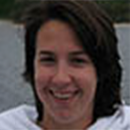
Emily Testa
Chemistry Department
B.S. 2005 - Chemistry, University of Chicago
PhD Thesis Advisor: Thomas Meade
Doctoral Research Project:
Emily Testas research, conducted in the laboratory of Professor Thomas Meade, centers on the synthesis and characterization of monodisperse polymeric MR contrast agents to be optimized with regards to tR and tm. The generated high relaxivity agent will have biological applications that include fate mapping and drug delivery tracking. To this end her work encompasses the use of peptoids as scaffolds for MR contrast agents, modification of nanoparticles with multiple functionalities, and comparison of different MR contrast agents. She also investigates the coordination chemistry of MR contrast agents as is relevant to these projects.

Bryan Tracy
Chemical Biological Engineering Department
B.S. 2004 - Chemical Engineering, North Carolina State University
PhD Thesis Advisor: E. Terry Papoutsakis
Doctoral Research Project:
The development of microbes for specialty chemical conversion, biofuel generation, and pharmaceutical production remains an immediate scientific and industrial goal. Particularly for bacteria, the pursuit of converting low value biomass and/or industry byproducts into transportation fuels (ethanol and butanol) is motivating a tremendous amount of bacterial strain development. Of considerable interest are bacterial species from the genus Clostridium because of their natural ability to degrade and ferment cellulosic material into ethanol and butanol. Unfortunately though, there are limited genetic tools applicable to Clostridium that may be employed for accelerating strain development. Thus the primary goal of Bryans research is to expand the genetic toolbox for all Clostridium species, and to concurrently apply these new approaches to the development of superior butanol producing strains. Specifically, he is developing new gene knockout techniques applicable to both solvent forming and pathogenic Clostridium species, such as C. acetobutylicum, thermocellum, botulinum, difficile and perfringens. Additionally, he is adapting reverse genetics approaches, such as plasmid libraries and high throughput flow-cytometry, to the generation and screening of mutant Clostridium libraries. By generating hundreds of thousands of random mutants, and coupling with sensitive multi-parametric screening techniques, their lab has proven the ability to generate higher butanol producing and more solvent tolerant strains in far less time than directed genetic approaches. Bryan continues to advance these techniques and to generate even more desirable phenotypes, which he hopes shall contribute to the worlds eminent need for alternative, sustainable and greener transportation fuels.

Michael Weiss
B.S. 2005 - Chemical Engineering, Vanderbilt University
PhD Thesis Advisor: Lonnie Shea
Doctoral Research Project:
The mammary microenvironment plays important and complex roles during tissue development and can contribute to the progression of breast cancer. I am designing synthetic hydrogels to controllably present microenvironmental cues, both mechanical and biochemical, to mammary epithelial cells and characterizing the resulting phenotype. These hydrogels allow known external cues to be presented separately and are appropriate for exploring the synergy of different factors. As differences in signaling pathways lead to diverse cellular structures, I use non-viral gene delivery to report on transcription factor activity important to specific pathways. A transfected cell array quantifies this activity non-invasively and in a high-throughput fashion, leading to profiles of cellular states at the level of signaling pathways. The effects of different microenvironments can thus be detected at the molecular level and can provide insight into how they affect disease progression.
2005 Trainees

Nathan Brown

Yoriel Marcano

Stacey Pace
2004 Trainees

Jacob Borden
Chemical Biological Engineering Department
B.S. 1997 - Chemical Engineering
Rose-Hulman Institute of Technology
M.S. 1999 - Chemical Engineering, Auburn University
M.B.A. 2002 - Business Administration, Springhill College
PhD Thesis Advisor: E. Terry Papoutsakis
Doctoral Research Project:
The bacteria Clostridium acetobutylicum is of interest for two main reasons. First, the relevance of increasing oil prices cannot be overstated, with an emphasis on finding alternate means of efficiently generating higher-chained organics. With the ability to produce the solvents ethanol, butanol, and acetone,C. acetobutylicumis of interest in regards to optimization and selectivity in converting raw sugars to desirable end products. SecondlyC. acetobutylicum is a suitable model organism for the study of common pathogens such as C. perfringens C. tetani, and C. botulinum. Until recently, gene/function analysis has relied on characterization of a single mutational event by a set of quantifiable phenotypes. However, a recent method has been proposed for imposing a phenotype, and extracting out genome-wide information concerning which genes are in fact responsible for bringing about the observed phenotype. Using genomic libraries, selective pressure will screen for relevant phenotypes (solvent tolerance, long fermentation duration, etc), and the selected library hybridized on a full-genome microarray. In this way, hybridization signals from the full-genome array can be traced to the genes conferring a growth advantage against the selective pressure.

Steve Bull
Department of Chemistry
B.S. 2002 - Chemistry, University of North Carolina, Chapel Hill
PhD Thesis advisor:Thomas J. MeadeSamuel I. Stupp
Doctoral Research Project:
Steve Bull started his NIH training appointment September 1, 2004. He received his B.S in chemistry (biochemistry tract) with honors from the University of North Carolina at Chapel Hill . Steve has finished his course requirements for his Ph.D. at Northwestern in Inorganic Chemistry. His research contains aspects of chemistry and biology and incorporating them with nanotechnology and Magnetic Resonance Imaging. More specifically his research is aimed at non-invasive imaging of self-assembling biomaterials. Steve's research, under Prof. Samuel I. Stupp and Thomas J. Meade, incorporates both nanotechnology and MRI. Steve is creating biocompatible MR active peptide amphiphile nanofibers for imaging within the body. This work is envisioned to allow for in vivo imaging of the implanted gels to study degradation and morphology. He is also working on length control of the self-assembling peptide amphiphile nanofibers, which will be used in drug delivery.

Ana Garcia
Chemical Biological Engineering Department
B.S. 2003 - Chemical Engineering, University of Texas, Austin
PhD Thesis Advisor: William M. Miller
Doctoral Research Project:
The ability to expand hematopoietic stem cells (HSCs) in an ex vivo environment would facilitate the development of many therapeutic applications for HSCs. HSCs of the bone marrow differentiate into all of the mature blood cells found in the body. Previous studies have shown that, although HSCs are able to self-replicate extensively in vivo, they tend to differentiate into more mature blood cells when cultured ex vivo. In other studies, HSC numbers have been maintained under conditions of co-culture with a stromal cell layer for up to seven weeks. However, co-culture with stromal cells is not a viable option for human transplantation due to contamination and regulatory issues. We are using a supported lipid monolayer containing bioactive lipopeptides to mimic the co-culture environment, which enables us to investigate key aspects of the bone marrow microenvironment. This well-defined system provides an easy way to isolate and combine various components of extracellular matrix and cell-surface molecules, such as different integrin ligands and immobilized cytokines, thereby allowing for a better understanding of the biological signals that regulate the self-renewal of adult HSCs.
2003 Trainees

Josephine Allen
Biomedical Engineering Department/IBiS Program
B.S. 2000 - Biology, California State Northridge
M.S. 2002 - Biology, California State Northridge
PhD Thesis advisor:Guillermo Ameer
Doctoral Research Project:
The characterization or understanding of cellular interactions with a biomaterial surface is important to the development of novel biomaterials and bioengineered tissues. The overall goal of Josy's research is to characterize cellular processes on a biomaterial in a non perturbing, real time, and quantitative manner, thereby enabling the monitoring of cell phenomics within bioengineered tissues. Specifically, we seek to describe the interactions between cells and newly developed biodegradable elastomeric biomaterials using a technique referred to as 4-D elastic light-scattering fingerprinting (4D-ELF). This study explores whether 4D-ELF, which was recently developed for the non-perturbing assessment of the morphology of living cells for cancer diagnosis, can be used as a tool to monitor cell differentiation. The spectral analysis of light scattered by living tissues can potentially provide information about the size scale of internal structures within the cell. We therefore hypothesize that interfacial cell/biomaterial interactions will affect sub-cellular structures in defined ways, giving rise to specific light-scattering fingerprints that can be used to describe a corresponding cellular process.
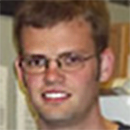
Keith Alsaker
Chemical Biological Engineering Department
B.S. 2000 - University of Minnesota-Twin Cities
PhD thesis advisor: E. Terry Papoutsakis
Doctoral Research Project:
With a US market of 1.8 billion pounds per year in 2001 and demand increasing, the solvent butanol is an attractive target for developing an environmentally friendly process using renewable resources. Such processes using strains related to the obligate anaerobe Clostridium acetobutylicum were commercially profitable until the mid-1950s. One reason for its demise was the lack of tools and methodologies to modify the catalyst itself, the microorganism. Keith's research aims to identify targets that may enhance tolerance of C. acetobutylicum to solvents. As cells in culture become stressed by butanol, the phenotype changes: the cellular membrane composition is altered, specialized proteins keep vital proteins properly folded, etc. Monitoring such stress responses at the transcriptional level using high throughput technologies like DNA microarrays is the first step towards the molecular understanding of solvent toxicity and, hence, towards the generation of improved, solvent-tolerant industrial strains.
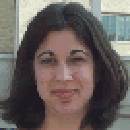
Joanna Gonzalez
Chemical Biological Engineering Department
B.S. 2002 - Chemical Engineering, M.I.T.
PhD Thesis Advisor: Vassily Hatzimanikatis
Doctoral Research Project:
Polyketides are important natural products since a number of them have been found to have important properties that allow them to function as antibiotics. The synthesis of polyketides includes a number of variables that can be altered to produce different polyketide molecules. However, due to the large number of variables, it has proven hard to predict at the beginning of an experiment the final structure of the resulting poyketide and consequently, its properties.I am working on applying computational methods to generate all the possible polyketide structures that can be synthesized from a specific set of monomers. It would then be possible, from the computer-generated list of structures, to determine a target polyketide structure and identify the pathway necessary to produce it. In other words, we would know which enzymes are necessary for the production of a specific polyketide and that knowledge might prove helpful in manipulating the genes to produce the target structure.

Ellen Kohlmeir
BMBCB Department/IBiS Program
B.A. 2000 - Biology, Luther College, Decorah, IA
PhD Thesis Advisor:Thomas J. Meade
Doctoral Research Project:
Ellen is developing novel applications for Dextran-coated iron oxide nanoparticles which will be used as imaging agents to increase contrast in magnetic resonance (MR) images. Dextran-coated iron oxide nanoparticles are biocompatible agents that are used as T2, MR contrast agents to enhance medical imaging. Ellen is working to develop and utilize multimodal imaging agents by adding a fluorescent molecule to the surface of the Dextran-coated iron oxide nanoparticles allowing for the detection of cellular uptake and cell migration by fluorescence microcopy as well as MRI. IOGO (iron oxide green oregon) is a multimodal contrast agent that was synthesized by adding a fluorophore (Oregon green 488) to the surface of dextran coated iron oxide particles. Cell studies, done with several different cell lines, have demonstrated the uptake of IOGO into cells and the ability to image the cells by fluorescence microscopy. This agent could have many medical applications. For example, one application we are considering is the labeling of pancreatic transplant tissue to track tissue viability and rejection. This will help in the study of pancreatic transplantation as a therapy for type 1 Diabetes. Another application that is being worked on is attaching a novel stilbene to the surface of the IOGO particles that has an affinity to the plaques that form in the brains of Alzheimer's patients. This would allow the plaques to be visualized by magnetic resonance imaging and provide an ante mortem diagnostic tool for Alzheimer's disease.
2002 Trainees
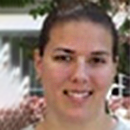
Courtney Berkholtz
Chemical Biological Engineering Department/IBiS Program
B.S. 2001 - Biology, University of Delaware
PhD Thesis advisor: Lonnie D. Shea
Doctoral Research Project:
Follicle maturation involves precise communication between the granulosa cells and the oocyte. There are many women who suffer from infertility diseases such as polycystic ovarian syndrome (PCOS), premature ovarian failure (POF), and chemotherapy-induced sterility that are a result of improper signaling and the cause of oocyte meiotic incompetence. An alginate hydrogel can provide the follicle with the three-dimensional stability required for proper development of the granulosa cell-oocyte complex (GOC). Within this matrix, the GOC will be able to grow and the biochemical environment between the granulosa cells and the oocyte can be examined. Determining the paracrine signaling will provide insight into the mechanism of maturation of the follicle and will ultimately lead to the development of a successful in vitro maturation technique.

Christopher Ramsborg
Chemical Biological Engineering Department
B.S. 1996 - Chemical Engineering, Leland Stanford Junior University
PhD thesis advisor: E. Terry Papoutsakis
Doctoral Research Project:
Ex vivo expanded T-lymphocytes based adoptive immunotherapy has the potential to develop into a powerful therapeutic tool. Ex vivo expanded T-lymphocytes can be used to treat iatrogenic infections, viral infections and several types of cancer. Controlling ex vivo culture conditions and understanding the effects of culture parameter perturbations is paramount to maximizing expansion while maintaining function. We use cDNA microarrays to observe the effects of autologous plasma on the temporal gene expression patterns of T-lymphocytes. We also develop cDNA microarray analysis methods, including advanced data normalization and filtering techniques as well as hierarchical clustering and self-organizing maps to: 1) Study the differential gene expression in ex vivo expanded T-lymphocytes cultured with versus without autologous plasma with emphasis on identifying novel serum induced genes, finding a gene expression fingerprint that correlates with ex vivo T-lymphocyte proliferation and explore the molecular basis of poorly expanding. 2) Investigate the transcriptional program of T-lymphocytes in the early activation period and evaluate the role of plasma in inducing T-lymphocyte activation pathways. 3) Construct new T-lymphocyte regulatory networks based on observed gene expression patterns. Microarray data will be validated using quantitative RT-PCR and flow cytometry. The improved understanding of the cellular mechanisms of ex vivo T-lymphocyte expansion could result in the modification of current protocols to increase expansion, thus improving clinical efficacy and decreasing ex vivo culture time.

Chris Tieche
Department of Biomedical Engineering
B.S. 1996 - Gen. Engineering, University of Illinois Urbana-Champaign
M.S.E. - 1999 - Aero and Astro Engineering - Purdue University
PhD Thesis Advisor: Shu Q. Liu
Doctoral Research Project:
Elastin, a major ECM protein constituting the elastic laminae and fibers of arterial vasculature, is not known as a ligand of the integrins found in platelets and leukocytes. Therefore, it is possible that integrin-mediated activation of these blood cells is not induced by elastin, thus facilitating the use of elastin as a potentially low thrombogenic blood interface material. Platelets and leukocytes, however, have a non-integrin elastin receptor, enabling attachment to elastin, potentially without the integrin-associated activation. In this study, we intend to construct elastin-rich matrix scaffolds for use as a blood interface material, and characterize the thrombogenicity and performance of these scaffolds. Elastin-rich scaffolds are created by subjecting rat abdominal aorta to an alkaline treatment for a specified time. Immunohistochemical methods are then employed to verify the composition of the elastin-rich, luminal surface of the scaffold. Blood cell adhesion, endothelialization, and neointima formation on the elastin-rich surface is compared to that of type III and type IV collagen surfaces. Our recent studies involving rat abdominal aorta implantation have demonstrated that the elastin-rich surface elicits lower platelet and leukocyte attachment and less intimal thickening than collagen-containing surfaces. This investigation may provide not only experimental evidence for the feasibility of using elastin-rich scaffolds as blood interface materials, but also fundamental information concerning the mechanistic aspects of biomatrix-based vascular tissue engineering.
2001 Trainees

Caralynn Helm
Chemical Biological Engineering Departmential
B.E. 2000 - Chemical Engineering, Vanderbilt University
M.S. 2002 - Chemical Engineering - Northwestern University
PhD Thesis Advisor: Melody A. Swartz
Doctoral Research Project:
The primary objective of Caras work is to create a functional, three-dimensional, interconnected capillary network in vitro using lymphatic endothelial cells embedded in a fibrin matrix. This effort utilizes a physiologically relevant matrix in conjunction with both functional drivers (e.g. interstitial flow) and biochemical actuators (e.g. matrix-bound growth factors) for the organization process. The matrix-bound growth factors, necessary for a system constantly undergoing interstitial flow, requires the creation of multi-domain fusion proteins that have an active protein of interest on one end and a substrate sequence on the other end to allow integration into the matrix. Additionally, she will optimize the physical matrix attributes of the fibrin, in effort to produce a synergy between the mechanical and chemical cues fostering the organization process.
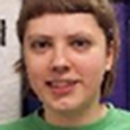
Melissa Starkey
Department of Civil Engineering/IBiS Program
BS - Biotechnology, Rutgers University
PhD thesis advisor: Mathew R. Parsek
Doctoral Research Project:
Melissa Starkey is researching exopolymeric substance (EPS) production in non-mucoid Psedumonas aeruginosa. P. aeruginosa is an important bacterium in both environmental and industrial contexts, but is perhaps most notable for its persistence in cystic fibrosis infections. It is commonly believed that alginate, a polymer of uronic acids, is a major constituent of P. aeruginosa exopolymeric substance (EPS) and that alginate is required for biofilm formation. Ms. Starkey and her collaborators recently demonstrated that alginate is not the major component of non-mucoid P. aeruginosa EPS, but rather, EPS isolated from strain PAO1 contains primarily neutral and amino sugars. Additionally, as compared to wild type strain PAO1, mutants defective in alginate production have similar biofilm phenotypes and antibiotic resistance profiles. These findings indicate that alginate is not necessary for biofilm formation or antibiotic resistance in P. aeruginosa. Ms. Starkeys current focus is on identifying genes responsible for non-mucoid EPS production and elucidating their roles in biofilm development and morphology.
2000 Trainees
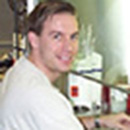
Jeffrey Michael Barrett
Department/Program: IBiS
B.S. in Molecular Biology (Microbiology Dept. at BYU)
PhD Thesis advisor: Karen Kaul
Doctoral Research Project:
The focus of Jeff Barrett's research is to identify the molecular factors involved in the establishment and growth of prostate cancer cells in the bone. Using a collagen gel co-culture system as an in vitro model, he is studying the effects of specific cell-cell interactions, including proliferation and migration of prostate cancer cells within the bone environment. Also, with this model he is investigating changes in gene expression that result from these specific interactions to ultimately identify potential diagnostic markers.
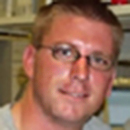
Jeffrey L. Dalsin
Biomedical Engineering Department
B.S. Life Sciences, University of Illinois
PhD thesis advisor: Phil Messersmith
Doctoral Research Project:
Jeff's current project involves the modification of clinically relevant biomaterial surfaces with novel molecules in order to mediate cell adhesion. Because of its well-known anti-fouling properties, poly(ethylene glycol) (PEG) is covalently attached to surfaces of various metals and metal oxides, including gold, titanium oxide, and chromium oxide through a bioinspired approach. NIH 3T3 fibroblasts are then cultured on these modified substrates and cell adhesion and spreading is examined using fluorescent microscopy.
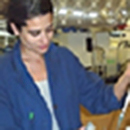
Tatiana Segura
Chemical Engineering Department
BS in Bioengineering from University of California Berkeley
PhD Thesis Advisor: Lonnie D. Shea
PhD Thesis Project:
Tissue engineering aims to develop functional tissue replacements by providing an environment that directs progenitor cell differentiation into a functional tissue. This environment is created using a scaffold that provides a mechanical support and function as a drug delivery vehicle. Tatiana's research involves developing hydrogel-based scaffolds for controlled gene-therapy vector delivery to tissues.
1999 Trainees
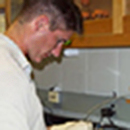
Kendrick C. Boardman, Jr.
Department of Biomedical Engineering
BS Mechanical Engineering, MIT, 1995
MS Biomedical Engineering, Northwestern University, 1999
PhD Thesis Advisor: Melody A. Swartz
Doctoral Research Project:
Rick Boardman is working in the Integrative Cell and Tissue Mechanics Laboratory of Melody Swartz investigating the role of interstitial fluid flow and a variety of other stimuli on lymphatic vessel development (lymphangiogenesis). He has developed a unique in vivo mouse tail model for observing lymphangiogenesis and examining its mechanical and molecular regulation. This will form a foundation for understanding the biological regulation of tissue fluid balance, including lymphedema and tumor spread through the lymphatics.
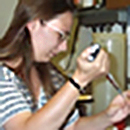
Erinn Mee
Department of BMBCB
Biology, Indiana University (B.S., 1997)
PhD thesis advisor: Neil E. Welker
Doctoral Research Project:
In the laboratory of Dr. Neil Welker, Ms. Mee is currently studying the effect of temperature on gene expression in Bacillus stearothermophilus, a gram-positive moderate thermophile. Using two-dimensional gel electrophoresis, it was determined that this organism utilizes a different subset of key genes depending on its growth temperature. By comparing the upstream region of several genes utilized only at higher growth temperatures, the lab hopes to find a regulatory sequence(s), and possible corresponding protein(s), used by the organism to "read" its environment. During the last year, Ms. Mee developed a novel subtractive hybridization technique to isolate such genes from B. stearothermophilus. Currently, she is performing Northern Blot Analysis to confirm the differential expression of genes isolated by this technique. She is also pursuing Two-Dimensional Gel Electrophoresis to identify additional temperature responsive genes that were overlooked by subtractive hybridization. Using these temperature responsive isolates, Ms. Mee plans to identify the function of the isolated genes through sequence homology, and elucidate the regulatory elements required for a temperature response.
1997 Trainees

Kenneth Chapman

Gregory Harbers

Jose Santiago

Wyatt Vreeland
1996 Trainees

Latonia Harris

Michelle McMullen

Anna Willett
1995 Trainees

Paul Collins

Vivian De Zengotita

James Marsh

Christi McDowell

Sigma Mostafa
1994 Trainees

Kathleen Carswell

Todd McAdams
1993 Trainees

Ruchir Desai

